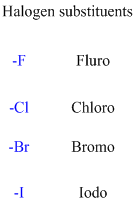
Concept explainers
Interpretation:
The nitrogen containing functional group should be identified for the given molecule.
Concept introduction:
If the compound is having oxygen atom it must be an alcohol
Example is given below
If any halogens are present in the molecule.

If the molecule is having hydroxyl group is called as an alcohol.
For example:

If the molecule is having (
For example:

If the molecule is having (
For example

If the molecule is having (
For example

If the molecule is having (
Example

If the molecule is having (
Example

The given compound is (
Example

Want to see the full answer?
Check out a sample textbook solution
Chapter 23 Solutions
CHEMISTRY:ATOMS FIRST (LL)>CUSTOM PKG.<
- Which functional groups are present in the following structure?arrow_forwardName the functional group present in each of the following structures: O O ║ ║ R‒C‒OH R‒C‒NH2 CH3-O-CH2CH3arrow_forwardTRUE OR FALSE (a) There are three amines with the molecular formula C3H9N. (b) Aldehydes, ketones, carboxylic acids, and esters all contain a carbonyl group. (c) A compound with the molecular formula of C3H6O may be either an aldehyde, a ketone, or a carboxylic acid. (d) Bond angles about the carbonyl carbon of an aldehyde, a ketone, a carboxylic acid, and an ester are all approximately 109.5°. (e) The molecular formula of the smallest aldehyde is C3H6O, and that of the smallest ketone is also C3H6O. (f) The molecular formula of the smallest carboxylic acid is C2H4O2.arrow_forward
- Ethynlestradiol acts as an estrogen (the primary female sex hormone) and has been used in contraceptives. Identify the functional groups in this compound. OH CH C CH Ноarrow_forwardYou were tasked to propose a structure for a compound with a chemical formula of C₂H₂N. In the laboratory, the compound appears as a clear, colorless liquid. To determine the structure of the compound, you subject the compound to several solubility tests and chemical tests. The observations for these tests are summarized: SOLUBILITY GROUP: Group V Insoluble in water and 10% NaOH but soluble in 10% HCI FUNCTIONAL GROUP/CLASS: Amine 1) Based on the results of the solubility tests and chemical tests, what is the most probable structure of C7H9N? Draw your answer in the box below. You may draw the compound using line-bond formula OR Lewis structure. |arrow_forwardWrite the chemical equation for the reaction of ethanoic acid with N-methylethanamine. Which is formula of this rule of reaction?arrow_forward
 Chemistry & Chemical ReactivityChemistryISBN:9781337399074Author:John C. Kotz, Paul M. Treichel, John Townsend, David TreichelPublisher:Cengage Learning
Chemistry & Chemical ReactivityChemistryISBN:9781337399074Author:John C. Kotz, Paul M. Treichel, John Townsend, David TreichelPublisher:Cengage Learning Chemistry & Chemical ReactivityChemistryISBN:9781133949640Author:John C. Kotz, Paul M. Treichel, John Townsend, David TreichelPublisher:Cengage Learning
Chemistry & Chemical ReactivityChemistryISBN:9781133949640Author:John C. Kotz, Paul M. Treichel, John Townsend, David TreichelPublisher:Cengage Learning Chemistry: Principles and PracticeChemistryISBN:9780534420123Author:Daniel L. Reger, Scott R. Goode, David W. Ball, Edward MercerPublisher:Cengage Learning
Chemistry: Principles and PracticeChemistryISBN:9780534420123Author:Daniel L. Reger, Scott R. Goode, David W. Ball, Edward MercerPublisher:Cengage Learning
 Organic And Biological ChemistryChemistryISBN:9781305081079Author:STOKER, H. Stephen (howard Stephen)Publisher:Cengage Learning,
Organic And Biological ChemistryChemistryISBN:9781305081079Author:STOKER, H. Stephen (howard Stephen)Publisher:Cengage Learning, General, Organic, and Biological ChemistryChemistryISBN:9781285853918Author:H. Stephen StokerPublisher:Cengage Learning
General, Organic, and Biological ChemistryChemistryISBN:9781285853918Author:H. Stephen StokerPublisher:Cengage Learning





